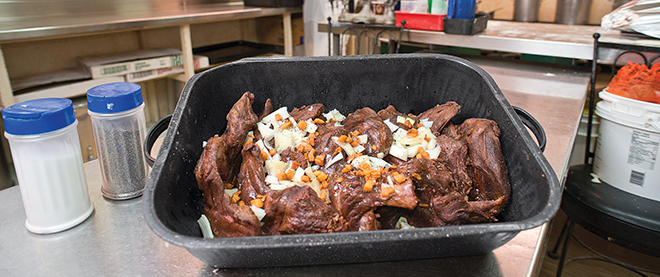A family love affair with seal cookery
Neither surf nor turf, seal challenges expectations of taste, but feeds a culture
Photograph by Greg Locke
Share

My family has been involved in sealing for more than five generations. Few of us were actual “swilers,” hunters risking the ice floes to harvest animals. We are instead devoted eaters of seal, phocid gourmets. In the Riches’ love affair with seal cookery my great-grandmother, whom I never met, stands out for her passion. A formidable woman with a striking resemblance to Winston Churchill, she was the go-to midwife in the east end of “Sin Jahns” at the turn of the last century. Uncles told how, when the sealing vessels returned to St. John’s she would dispatch a grandchild to purchase the first, dearest flippers brought ashore. She would sample the flesh the moment it came in the door, blood running down her chin. Great Grandmother was, after a hard winter, likely suffering from a vitamin or mineral deficiency that compelled her to such behaviour.
My wife is from Nova Scotia; some of her ancestors are Palatinate Germans, and she is not a fan. My theory is that one cannot, later in life, make seals’ distinctly fishy taste jibe with its intense—the red of the flesh veers to black—meatiness. The common murre, the migratory sea bird known here as turr, is another delicacy that challenges this expectation of taste. With a diet consisting primarily of capelin, their flesh takes on a piscine attribute. To the tongue, turr is neither fish nor fowl, seal neither surf nor turf, but rather both at once.
When I was a boy, the meat was purchased from sealers off the large vessels at the harbour apron. That seal [was] “seasoned” during the return to port, the blubber coming to possess a funky rancidity. These days the boats involved in the much smaller hunt possess such sophisticated refrigeration that the raw meat has a delicate scent. While the smell of seal cooking is distinctive, it doesn’t linger in the house like it used to. The white-coats, the dew-eyed “baby seals” that attracted so much misplaced pity, and drew the outraged likes of Brigitte Bardot to our shores, are no longer taken. The meat now comes from the older, less camera-ready Raggedy Jacks. I buy mine at one of two local seafood shops or at Belbin’s, a grocery in the east end. It’s sold on Styrofoam trays wrapped in cellophane.
At my grandmother’s house a meal of flippers was preceded by an appetizer of “hands,” the ends of the seal’s flipper, so named because of their resemblance to the human appendage. These, after having been boiled, were served cold. The cooked connective tissue of the hands is white and gelatinous. Their texture resembles that of the duck feet on offer at your regular dim sum. I never see “hands” for sale anymore, or hearts, which were sold, floating in blood, in old 10-gallon salt-beef buckets.
Mainlanders inexplicably find the sound of “flipper pie” funny. It’s a meat pie like most others, slowly braised meat in gravy covered by a pastry. Flippers are first seared in fat rendered from salt pork and then put in the pan with a mirepoix. A roux is added. Seasoning is limited to black pepper and a few dashes of Worcestershire sauce. Cook at 325°, covered, for two hours.
Seal is good for you, high in this thing and that, low in other bad elements. I find it restorative but put its tonic effect down to the lift one gets from ritual, from a delicious seasonal meal, especially one of the spring, which puts you back in sync with cycles of the earth and the sea and of the family table. With the best of these annual feasts (lobsters, partridge, turnip greens, capelin), you want a couple of feeds, that’s all. There no sense freezing flippers, no matter how well they keep; they don’t taste right at the wrong time of year. Canned seal, for reasons I don’t understand, isn’t very good at all.
The appetite for seal in Newfoundland remains hearty. Besides the home cooking there are plentiful church suppers and even takeaway preparations. But the taste will wane with the inevitable erosion of Newfoundland’s culture. Unavailable in a President’s Choice frozen “It’s Too Good To Be True Newfie Soy-Flipper Pie,” it will cease to be eaten by the children of expats, or by anyone but Arctic peoples until such time as their home and that of the seals melts away.
Todd Perrin’s Cold Smoked Seal Loin
Todd Perrin is the celebrated owner and head chef of the Mallard Cottage restaurant in St. John’s. He was also a contestant on Top Chef Canada, where he once cooked seal.
8 seal loins, trimmed of all fat
For the brine:
8 litres water
2 cups apple cider
1 cup apple cider vinegar
2 cups salt
2 cups brown sugar
6 Bay leaves
Bunch fresh thyme
Combine all and bring to simmer. While brine is heating, dry roast the following dry spices:
3 TBS black peppercorns
3 TBS mustard seed
5 TBS coriander seed
3 TBS fennel seed
1 TBS dried chilies
Add to simmering brine and continue to simmer for 1.5 hours. Cool.
Cover loins with brine in non-reactive container and leave in refrigerator approximately 12-16 hours.
Remove from brine, pat dry and leave in refrigerator for further 6 hours on drying rack, uncovered.
Cold smoke, six to eight hours. Wood of choice – I like alder.
Remove from smoker, and place in 500F oven for 5 minutes. Remove from oven and cool. Chill in refrigerator. Slice thinly and serve, carpaccio style.